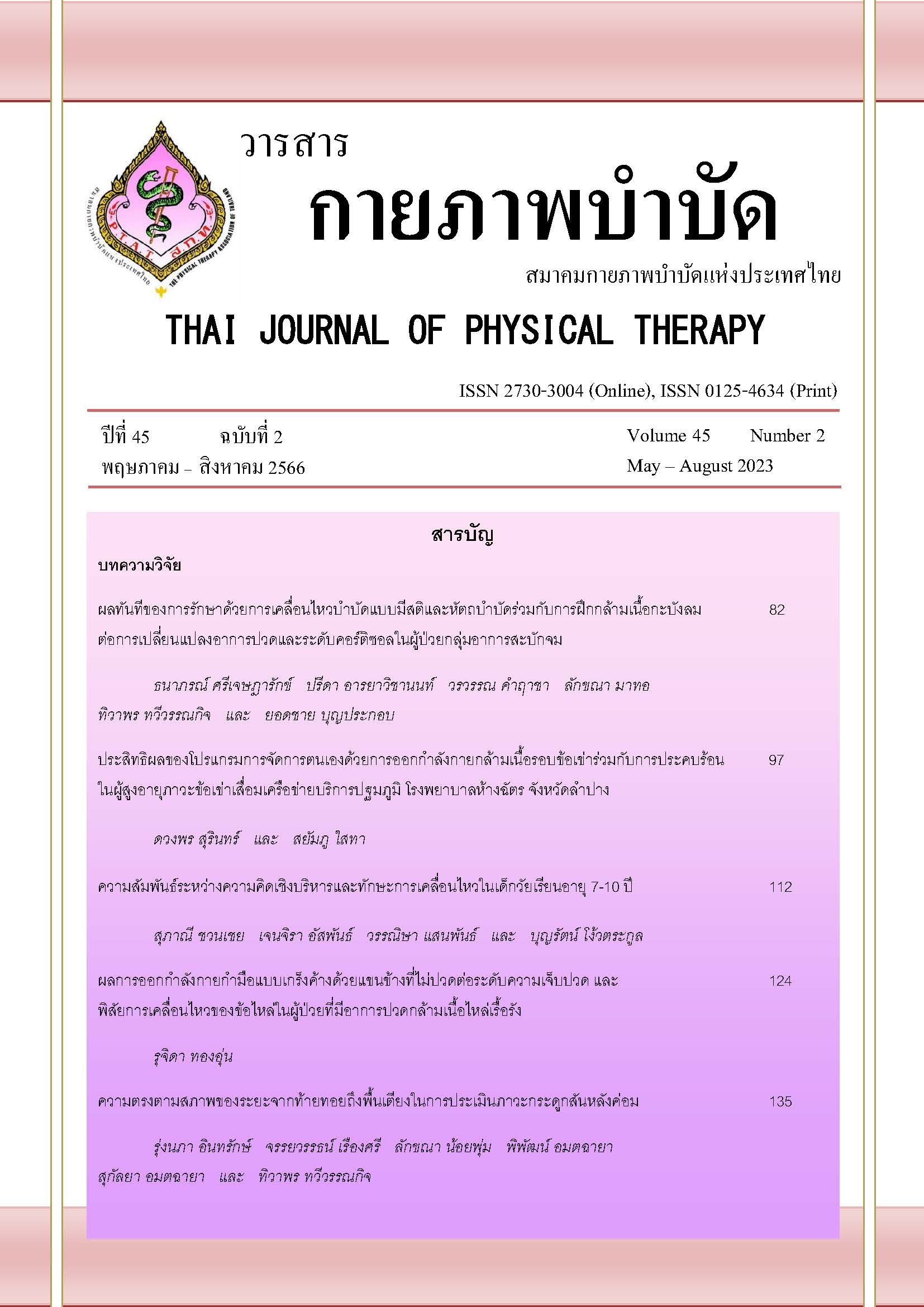ผลทันทีของการรักษาด้วยการเคลื่อนไหวบำบัดแบบมีสติและหัตถบำบัดร่วมกับการฝึกกล้ามเนื้อกะบังลมต่อการเปลี่ยนแปลงอาการปวดและระดับคอร์ติซอลในผู้ป่วยกลุ่มอาการสะบักจม
Main Article Content
บทคัดย่อ
ที่มาและความสำคัญ: กลุ่มอาการสะบักจมเป็นอาการปวดเรื้อรังจึงส่งผลทั้งความผิดปกติทางกายและทางจิตใจ และมีความสัมพันธ์กับระดับความเครียดได้ การพัฒนาแนวทางการรักษาการเคลื่อนไหวบำบัดแบบมีสติจึงอาจมีผลในการปรับสมดุลการทำงานของระบบประสาทอัตโนมัติได้
วัตถุประสงค์: เพื่อศึกษาผลทันทีของการเคลื่อนไหวบำบัดแบบมีสติและหัตถบำบัดร่วมกับการฝึกกล้ามเนื้อกะบังลม และเปรียบเทียบผลทันทีระหว่างกลุ่มที่ได้รับการรักษาด้วยการเคลื่อนไหวบำบัดแบบมีสติและหัตถบำบัดร่วมกับการฝึกกล้ามเนื้อกะบังลมและกลุ่มที่ได้รับการรักษาด้วยการยืดกล้ามเนื้อรอบกระดูกสะบักด้วยตนเองที่มีต่อระดับอาการปวด ระดับกั้นความเจ็บปวด และระดับคอร์ติซอลในผู้ป่วยกลุ่มอาการสะบักจม
วิธีการวิจัย: ผู้ป่วยกลุ่มอาการสะบักจม จำนวน 38 คน ถูกแบ่งเป็น 2 กลุ่ม ได้แก่ กลุ่มทดลองรักษาด้วยการเคลื่อนไหวบำบัดแบบมีสติและหัตถบำบัดร่วมกับการฝึกกล้ามเนื้อกะบังลมและกลุ่มควบคุมได้รับการยืดกล้ามเนื้อรอบกระดูกสะบักด้วยตนเอง อาสาสมัครได้รับการตรวจประเมินระดับอาการปวด ระดับกั้นความเจ็บปวด และระดับคอร์ติซอล ก่อนการรักษาและหลังการรักษาทันทีประเมินผลก่อนและหลังการรักษาภายในกลุ่มด้วยสถิติ Paired samples t-test และสถิติ Wilcoxon Sign rank test ประเมินผลความแตกต่างระหว่างกลุ่มด้วยสถิติ independent t-testและสถิติ Mann Whitney U test
ผลการวิจัย:การเปรียบเทียบผลภายในกลุ่มพบว่าระดับอาการปวดและระดับคอร์ติซอลลดลงอย่างมีนัยสำคัญทางสถิติในทั้งสองกลุ่ม (p<0.05) ในขณะที่ระดับกั้นความเจ็บปวดเพิ่มขึ้นอย่างมีนัยสำคัญทางสถิติเฉพาะในกลุ่มทดลอง (p<0.05) อย่างไรก็ตาม ระดับของอาการปวดและระดับกั้นความเจ็บปวดไม่แตกต่างกันเมื่อเปรียบเทียบระหว่างกลุ่ม (p>0.05) ในขณะที่ระดับคอร์ติซอลในกลุ่มทดลองน้อยกว่ากลุ่มควบคุมอย่างมีนัยสำคัญทางสถิติ (p<0.05)
สรุปผล: การเคลื่อนไหวบำบัดแบบมีสติและหัตถบำบัดร่วมกับการฝึกกล้ามเนื้อกะบังลมมีผลทันทีในการลดระดับอาการปวดระดับคอร์ติซอลและเพิ่มระดับกั้นความเจ็บปวดและการรักษานี้มีผลทันทีในการลดระดับคอร์ติซอลดีกว่าการยืดกล้ามเนื้อรอบกระดูกสะบักด้วยตนเอง
Article Details

อนุญาตภายใต้เงื่อนไข Creative Commons Attribution-NonCommercial-NoDerivatives 4.0 International License.
เอกสารอ้างอิง
Abrams B. Scapulocostal syndrome. In: Pain management. 2nd ed. Philadelphia: Saunders; 2011. p. 588–92.
Waldman SD. Atlas of uncommon pain syndromes. 3rded. Philadelphia, PA: Saunders Elsevier; 2014. p. 96-8
Schmerl M, Sangster J. Clinical update. Scapulo-costal syndrome. Australas Chiropr Osteopathy 2002; 10(2): 85–6.
Osborne TL, Jensen MP, Ehde DM, Hanley MA, Kraft G. Psychosocial factors associated with pain intensity, pain-related interference, and psychological functioning in persons with multiple sclerosis and pain: Pain. 2007; 127(1): 52-62.
Jafri MS. Mechanisms of myofascial pain. Int Sch Res Notices 2014; 2014: 523924
Brawn J, Morotti M, Zondervan KT, Becker CM, Vincent K. Central changes associated with chronic pelvic pain and endometriosis. Hum Reprod Update 2014; 20: 737–47
Boonprakob Y, Phadungkit S, Nongharnpitak S, Srijessadarak T, Supasatean W, Nakhengrit C. Trigger point: Curable or palliative symptoms. Bull Chiang Mai Assoc Med Sci 2016; 49(1): 155-66.
Moseley GL. A pain neuromatrix approach to patients with chronic pain. Man Ther. 2003; 8(3): 130-40.
Abdallah CG and Geha P. Chronic pain and chronic Stress: two sides of the same coin?. Chronic Stress (Thousand Oaks). 2017; 1: 1-10.
Taylor AG, Goehler LE, Galper DI, Innes KE, Bourguignon C. Top-down and bottom-up mechanisms in mind-body medicine: development of an integrative framework for psychophysiological research. Explore N Y N.2010; 6(1):29-41.
Grossman P, Niemann L, Schmidt S, Walach H. Mindfulness-based stress reduction and health benefits. J Psychosom Res.2004; 57(1): 35–43.
Panta P. The possible role of meditation in myofascial pain syndrome: A new hypothesis. Indian J Palliat Care.2017; 23(2): 180-7.
Chandla SS, Sood S, Dogra R, Das S, Shukla SK, Gupta S. Effect of short-term practice of pranayamic breathing exercises on cognition, anxiety, general well being and heart rate variability. J Indian Med Assoc. 2013; 111: 662–5.
Bradley H, Esformes J. Breathing pattern disorders and functional movement. Int J Sports Phys Ther.2014; 9(1): 28–39.
Paine R, Voight ML. The role of the scapula. Int. J. Sports Phys. Ther. 2013, 8, 617–29.
Srijessadarak T, Arayawichanon P, Kanpittaya J,Boonprakob Y. Diaphragmatic mobility and chest expansion in patients with scapulocostal syndrome: A cross-sectional study. Healthcare (Basel). 2022; 10(5): 1-9.
Simons DG, Travell JG, Simons LS, Travell JG. Travell& Simons’ myofascial pain and dysfunction: the trigger point manual. 2nd ed. Baltimore: Williams & Wilkins; 1999. 1 p.
Buttagat V, Eungpinichpong W, Chatchawan U, Arayawichanon P. Therapeutic effects of traditional Thai massage on pain, muscle tension and anxiety in patients with scapulocostal syndrome: A randomized single-blinded pilot study. J Bodyw Mov Ther. 2012; 16(1): 57–63.
Borm GF, Fransen J, Lemmens WA. A simple sample size formula for analysis of covariance in randomized clinical trials. J Clin Epidemiol. 2007; 60(12): 1234-8.
Gallagher EJ, Bijur PE, Latimer C, Silver W. Reliability and validity of visual analog scale for acute abdominal pain in the ED. AM J Emerg Med.2002; 20(4): 287-90.
Takai N, Yamaguchi M, Aragaki T, Eto K, Uchihashi K, Nishikawa Y. Effect of psychological stress on the salivary cortisol and amylase levels in healthy young adults. Arch Oral Biol.2004; 49(12): 963–8.
Wannapong N, Boonprakob Y, Chatchawan U, Wanpen S, Phadungkit S. Immediate and short-term effect of modified active release technique (mART) in patients with scapulocostal syndrome. J Assoc Med Sci.2016; 49:(1): 134-45.
Mackawan S, Eungpinichpong W, Pantumethakul R, Chatchawan U, Hunsawong T, Arayawichanon P. Effects of traditional Thai massage versus joint mobilization on substance P and pain perception in patients with non-specific low back pain. J Bodyw Mov Ther.2007; 11(1): 9-16.
Melzack R, Wall PD. Pain mechanisms: a new theory. Science.1965; 150: 971–9.
Field T. Massage therapy research review. Complement Ther Clin Pract. 2014; 20(4): 224-29.
Zeidan F, Martucci KT, Kraft RA, Gordon NS, McHaffie JG, Coghill RC. Brain mechanisms supporting the modulation of pain by mindfulness meditation. J Neurosci Off J Soc Neurosci. 2011; 31(14): 5540–8.
Pickar JG. Neurophysiological effects of spinal manipulation. Spine J. 2002; 2(5): 357-71.
Gerritsen RJS and Band GPH. Breath of life: the respiratory vagal stimulation model of contemplative activity. Front Hum Neurosci. 2018; 12: 1-25.
Jafari H, Courtois I, Bergh OVD, Vlaeyen JWS, Diest IV. Pain and respiration: a systematic review. Pain. 2017;158(6): 995-1006.
Pal GK, Velkumary S, Madanmohan. Effect of short-term practice of breathing exercise on autonomic functions in normal human volunteers. Indian J Med Res. 2004; 120: 115-21.
Jerath R, EdryJ, Barnes VA, Jerath V. Physiology of long pranayamic breathing: neural respiratory elements may provide a mechanism that explains how slow deep breathing shifts the autonomic nervous system. Med Hypotheses. 2006;67(3):566-71.
Russo MA, Santarelli DM, O’Rourke D. The physiological effects of slow breathing in the healthy human. Breathe (Sheff). 2017; 13(4): 298–309.


